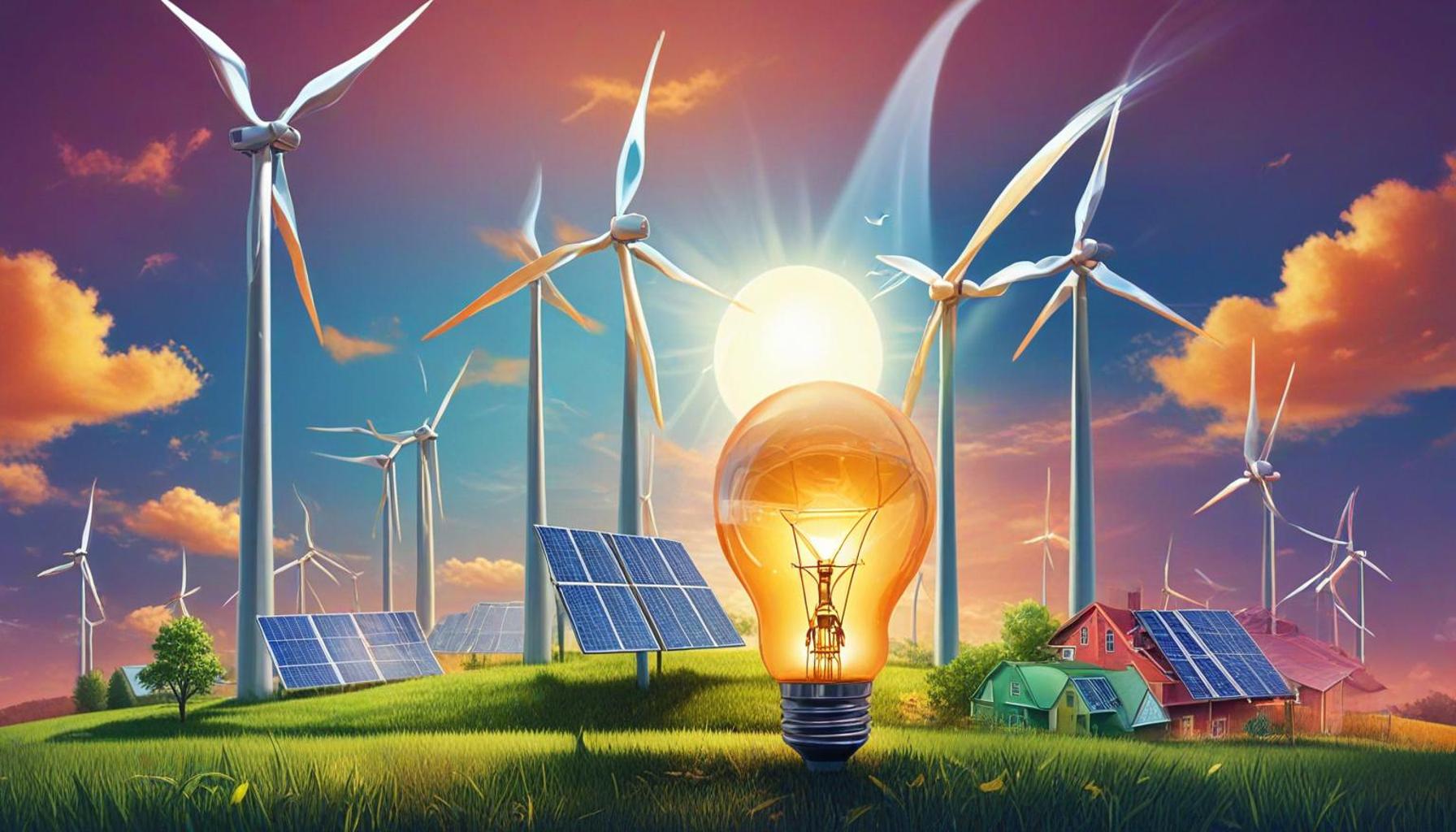Investment Opportunities in Renewable Energy: Perspectives for the Sustainable Future of the USA

Introduction
The shift towards renewable energy is not just a trend; it’s a necessary evolution for sustainability and economic growth. As the United States looks to address climate change, innovative investment opportunities are emerging across various renewable sectors. These opportunities can shape a greener future while providing substantial financial returns.
Investing in renewable energy offers several benefits that are crucial for both the environment and the economy. For instance, reducing greenhouse gas emissions is vital for combating climate change. By transitioning to cleaner energy sources, such as solar and wind, the U.S. can take significant strides in lowering its carbon footprint and meeting global climate goals.
Moreover, renewable energy investments create jobs and foster local economies. According to the U.S. Department of Energy, the renewable energy sector employed over 3 million workers in 2020, and this number continues to grow. By investing in solar or wind projects, communities can stimulate job growth in areas like construction, installation, maintenance, and manufacturing.
Additionally, investing in renewables promotes energy independence, which enhances national security. By reducing reliance on fossil fuels—often imported from geopolitically unstable regions—the U.S. can secure its energy future and protect its economy from global fluctuations in oil and gas prices.
With advancements in technology, several renewable energy sources are becoming increasingly viable. Here are some key sectors to consider:
- Solar Energy: Rooftop solar panels and solar farms are proliferating across the country. Investing in companies that manufacture solar technology or in community solar projects can yield significant returns while promoting sustainable energy.
- Wind Energy: Both onshore and offshore wind projects are gaining traction, especially in states like Texas and California, which have been pioneers in wind energy development. These projects not only generate electricity but also create jobs in farming, construction, and tourism.
- Hydropower: Investing in infrastructure for hydropower can harness the flow of rivers and provide consistent energy. With careful management, hydropower continues to be one of the most mature and reliable sources of renewable energy available.
As the U.S. government implements policies to encourage renewable energy adoption, savvy investors can capitalize on these emerging trends. Government incentives such as tax credits, grants, and subsidies make investing in renewables not only environmentally responsible but financially attractive. This article delves into the landscape of renewable energy investments, showcasing the potentials that pave the way for a sustainable future, making it a win-win scenario for both the planet and your portfolio.
DISCOVER MORE: Click here to learn how interest rates can affect your finances
Key Opportunities in Renewable Energy Investment
The world is witnessing a rapid transformation in energy use, especially as the United States commits to reducing its dependency on fossil fuels. For prospective investors, understanding the various renewable energy sectors can open up a wealth of opportunities. Not only can these investments help combat climate change, but they also align with a growing trend towards sustainability among consumers and businesses alike.
One of the most prominent sectors is solar energy. The cost of photovoltaic (PV) solar panels has plummeted over the past decade, making solar installations more accessible for both residential and commercial consumers. An investment in solar energy can range from small-scale projects, like residential rooftop installations, to larger utility-scale solar farms. For example, in states like California and Florida, a surge in solar farm developments has created lucrative investment opportunities for individuals and companies looking for long-term returns. Investing in solar companies or mutual funds that focus on renewable energy can yield both financial and environmental dividends.
Wind energy represents another promising avenue for investment. With advancements in turbine technology and efficiency, wind energy is becoming more cost-effective, making it one of the fastest-growing sectors in the U.S. energy landscape. Both onshore and offshore wind farms are under development, with states like Texas leading the charge due to their favorable geography and strong wind currents. An investor can consider funding wind projects or buying shares in wind energy companies. For instance, Ørsted has made significant strides in offshore wind investments, presenting a valuable option for those interested in this rapidly expanding market.
Hydropower continues to be a stalwart in the renewable energy sector. As one of the oldest sources of renewable energy, it provides a consistent and reliable power supply. By investing in hydropower projects, stakeholders can benefit from long-term revenue streams, as these facilities often have long operational lifetimes. Additionally, the Federal Energy Regulatory Commission (FERC) is working to streamline the licensing process for new projects, which can spur investment possibilities. Investors should look into opportunities that focus on updating aging infrastructure or developing new small-scale hydropower stations.
In addition to these renewable sources, energy storage has emerged as a crucial component of the renewable energy ecosystem. As energy generation from sources like solar and wind is intermittent, efficient storage solutions are essential for maintaining a stable energy supply. Companies focused on battery technology and other energy storage solutions are gaining traction. Investing in energy storage technologies could provide significant returns as the demand for reliable energy increases with the expansion of renewable sources.
Investors should also remain aware of emerging technologies that enhance the efficiency and effectiveness of renewable energy systems. Innovations such as smart grids, hydrogen fuel cells, and carbon capture and storage (CCS) technologies offer exciting possibilities for modernization and investment. As the market for these technologies burgeons, savvy investors can find unique opportunities that support sustainability while also yielding robust financial returns.
In sum, the renewable energy sector presents a broad spectrum of investment opportunities that cater to diverse interests and risk appetites. By focusing on established sectors like solar, wind, and hydropower, as well as innovative emerging technologies, investors can contribute to a cleaner, more sustainable future while enhancing their financial portfolios.
DISCOVER MORE: Click here to learn how to apply for the Emirates Skywards Rewards World Elite Mastercard</a
The Role of Government Initiatives and Incentives
The potential for profitable investments in renewable energy is further amplified by a variety of state and federal government initiatives designed to encourage the growth of clean energy technologies. These programs not only support the transition to a more sustainable economy but also create a favorable environment for investors. Understanding these incentives is crucial for maximizing returns on renewable energy investments.
At the federal level, the Investment Tax Credit (ITC) and the Production Tax Credit (PTC) are two significant incentives that drive investment in renewable energy projects. The ITC allows investors to deduct a significant percentage of their investment in solar energy systems from their federal taxes. Currently, the tax credit is set at 26%, offering a substantial return on investment potential for solar projects. Similarly, the PTC provides financial incentives for investments in wind power, offering credits per kilowatt-hour of electricity generated, which can further improve the economic viability of wind farms.
Many states also have their own renewable energy incentives, fall under the category of Renewable Portfolio Standards (RPS). These mandates require utilities to obtain a certain percentage of their energy from renewable sources, stimulating demand for new installations. States like New York, Massachusetts, and California have implemented aggressive RPS targets that incentivize the addition of solar and wind capacity. Investors can benefit from these regulatory frameworks, creating a more stable investment climate.
Community Solar and Cooperative Models
As the demand for accessible renewable energy solutions grows, community solar projects are emerging as an innovative investment avenue. These initiatives allow multiple stakeholders—such as households, businesses, and local governments—to invest in a shared solar energy system. Participants in community solar programs can purchase or lease a portion of the solar capacity, directly benefiting from the electricity produced. This model not only democratizes access to renewable energy but also creates a sense of community ownership.
In addition to community solar, energy cooperatives provide another avenue for investment. These cooperatives operate by pooling resources from members who share a common goal of sustainable energy development. By forming or joining cooperative groups, individuals and businesses can collectively invest in larger renewable energy projects that might otherwise be unattainable. This model fosters local engagement and can generate long-term economic benefits for all members involved.
Corporate Social Responsibility and Sustainable Investing
In today’s socially conscious market, the concept of Environmental, Social, and Governance (ESG) criteria has gained significant traction. Investors are increasingly seeking opportunities that align with their values, prompting corporations to adopt sustainable practices. Notably, companies that prioritize renewable energy investments and sustainability initiatives often enhance their brand and drive consumer loyalty. For investors, identifying firms committed to these principles can lead to profitable investments, especially as the demand for responsible corporate citizenship continues to rise.
Additionally, many mutual funds and exchange-traded funds (ETFs) focus exclusively on clean energy investments. By investing in these funds, individuals can gain diversified exposure to the renewable energy sector while supporting companies committed to sustainability. This strategy allows investors to participate in the clean energy transition without needing to select individual stocks actively.
Ultimately, the intersection of government incentives, community engagement, and corporate responsibility presents a multifaceted approach for investors interested in renewable energy. By tapping into these aspects, individuals and institutions alike can find several promising avenues to pursue their financial interests while contributing to a sustainable future for the United States. The opportunities in this sector are as dynamic as they are diverse, positioning investors to harness the momentum towards a greener tomorrow.
DIVE DEEPER: Click here to discover how to spot the next big startup
Conclusion
In conclusion, the landscape of renewable energy investment in the United States offers a wealth of opportunities for those looking to align their financial goals with sustainable practices. As outlined, the growing emphasis on clean energy not only addresses pressing environmental challenges but also presents significant financial viability for investors. With robust government incentives such as the Investment Tax Credit (ITC) and Production Tax Credit (PTC), alongside progressive Renewable Portfolio Standards, the playing field for renewable energy projects becomes increasingly favorable.
The innovative models of community solar and energy cooperatives further enhance this investment landscape by allowing individuals and businesses to promote local energy solutions and share the benefits of collective investment. Additionally, the rise of Environmental, Social, and Governance (ESG) criteria reflects a broader societal shift toward sustainable investing, adding another layer of appeal for conscientious investors. By prioritizing firms that integrate sustainability into their core operations, investors can support not just their financial interests but also the larger goal of environmental stewardship.
Ultimately, the convergence of these factors forms a robust ecosystem encouraging renewable energy growth. Aspiring investors should reflect on the diversity and dynamism of this sector, recognizing that there are numerous avenues to invest in a sustainable future while also capitalizing on the financial rewards it has to offer. As we move forward, harnessing these opportunities will be critical in driving the United States toward a greener, more sustainable tomorrow.


